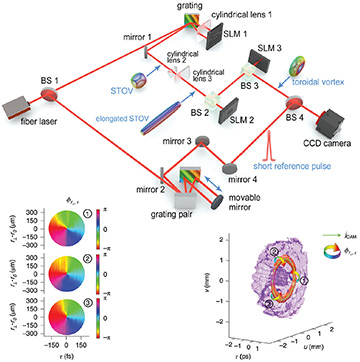 Generation and characterization of toroidal vortices of light. [C. Wan et al. Nat. Photon. 16, 519 (2022)] [Enlarge figure]
Generation and characterization of toroidal vortices of light. [C. Wan et al. Nat. Photon. 16, 519 (2022)] [Enlarge figure]
Toroidal vortices, or vortex rings, are commonly observed in fluidics, with propagating ring-shaped structures and whirling disturbances rotating around the ring. This amazing topology has stirred research interest in different disciplines; the earliest scientific study dates to 1867, when Lord Kelvin proposed the vortex-atom model. Now, advances in spatiotemporal manipulation and sculpting of light make it possible to create this intriguing topology in optics.1
Recently, our group exploited a pulse shaper with a 2D spatial light modulator to produce spatiotemporally coupled wave packets, such as a spatiotemporal optical vortex (STOV), that carry transverse orbital angular momentum. This simple, flexible apparatus can function as a powerful tool for generating a variety of spatiotemporal wave packets, including Bessel STOVs2 and STOV lattices.3
Further, combining this spatiotemporal- modulation capability with spatial modulation offers an unprecedented level of light-field control. For example, adding spatial modulation after the spatiotemporal modulation allows the creation of wave packets with both spatiotemporal and spatial vortices.4 Taking this idea one step further, we successfully demonstrated an optical toroidal vortex by applying a spatial conformal mapping to a STOV.1
Optical toroidal vortices constitute a solution to Maxwell’s equations that can propagate without distortion in a uniform medium with anomalous group-velocity dispersion.1 To generate such an optical wave packet, a laser pulse is transformed into a STOV using the 2D pulse shaper. The STOV is stretched along the vortex line into a spatiotemporal vortex pipe with a pair of cylindrical lenses. Then the spatiotemporal vortex pipe is wrapped around, through conformal mapping that transforms cartesian coordinates into polar coordinates to form a toroidal vortex.
The power flows within optical toroidal vortices resembles those in their fluidic counterparts, with local flows whirling around a ring-shaped vortex core while the overall wave packets move forward. We believe the simple, flexible generation method we have demonstrated offers an unprecedented level of light manipulation in space and time, opening a new approach to generating spatiotemporal wave packets with much more sophisticated topologies.
We anticipate that the generation of optical toroidal vortices will spur a wealth of physical mechanisms to explore, including toroidal electrodynamics, toroidal plasma physics, complex symmetry and topology for localized waves, and interaction of light with nanostructures.
Researchers
Chenhao Wan, University of Shanghai for Science and Technology, Shanghai, China, and Huazhong University of Science and Technology, Wuhan, China
Qian Cao, Jian Chen and Qiwen Zhan, University of Shanghai for Science and Technology and Zhangjiang Laboratory, Shanghai, China
Andy Chong, Pusan National University, Busan, Republic of Korea
References
1. C. Wan et al. Nat. Photon. 16, 519 (2022).
2. Q. Cao et al. Sci. Bull. 67, 133 (2022).
3. Q. Cao et al. Photon. Res. 9, 2261 (2021).
4. C. Wan et al. Nat. Sci. Rev. 9, nwab149 (2021).
